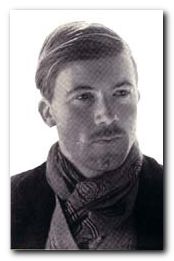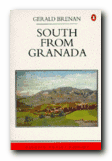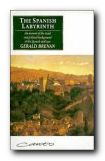his life, writings, and adventures
 Gerald Brenan (1894-1987) was born in Malta, the son of an English army officer. After spending some of his childhood in South Africa and India, he grew up in an isolated Cotswold village. He studied at Radley College and then the military academy at Sandhurst. Travel and adventure were to be his way of life, and at sixteen he ran away from home. His aim was to reach Central Asia but the outbreak of the Balkan War and shortage of money caused him to return to England. He studied to enter the Indian Police (as did his near-contemporary George Orwell) but on the outbreak of the First World War, he joined the army. He spent over two years on the Western Front, reaching the rank of captain and winning a Military Cross and a Croix de Guerre.
Gerald Brenan (1894-1987) was born in Malta, the son of an English army officer. After spending some of his childhood in South Africa and India, he grew up in an isolated Cotswold village. He studied at Radley College and then the military academy at Sandhurst. Travel and adventure were to be his way of life, and at sixteen he ran away from home. His aim was to reach Central Asia but the outbreak of the Balkan War and shortage of money caused him to return to England. He studied to enter the Indian Police (as did his near-contemporary George Orwell) but on the outbreak of the First World War, he joined the army. He spent over two years on the Western Front, reaching the rank of captain and winning a Military Cross and a Croix de Guerre.
Following the end of the war, his fellow officer and friend Ralph Partridge introduced him to the fabled Bloomsbury Group. It was through Partridge that Brenan met Lytton Strachey, Dora Carrington, and Virginia Woolf. As soon as he was released from military service he packed a rucksack and left England aboard a ship bound for Spain. He was disillusioned with the way of life in England and with the stifling social and sexual hypocrisies of British bourgeois society. He rebelled against becoming part of it and, being a romantic and adventurer, resolved to seek a more breathable atmosphere in which to live.
He also wanted to educate himself and become a writer. As he records in his best known travel memoir, South from Granada, he felt ashamed that his public school upbringing had left him with a very poor education. He shipped 2,000 books out to his chosen destination – an area deep in Andalucia known as ‘La Alpujarra’.
 South from Granada is a classic in which Brenan describes setting up home in a remote Spanish village in the 1920s. He has a marvellous grasp of geography; he captures the rugged atmosphere of the region; and he has a particularly detailed knowledge of botany. Local characters and customs are vividly recounted. Bloomsbury enthusiasts will be delighted his by hilarious accounts of visits made by Lytton Strachey and Virginia Woolf under very difficult conditions, as well as a meeting with Roger Fry in Almeria.
South from Granada is a classic in which Brenan describes setting up home in a remote Spanish village in the 1920s. He has a marvellous grasp of geography; he captures the rugged atmosphere of the region; and he has a particularly detailed knowledge of botany. Local characters and customs are vividly recounted. Bloomsbury enthusiasts will be delighted his by hilarious accounts of visits made by Lytton Strachey and Virginia Woolf under very difficult conditions, as well as a meeting with Roger Fry in Almeria.
Ralph Partridge and Dora Carrington, recently married, also visited him with Lytton Strachey in 1920, and Carrington’s fondness for Brenan is thought to have started on this trip. She carried on an extensive correspondence with Brenan for the next several years and in 1922 they had a brief affair, which was rapidly discovered by Partridge. There was a year of silence between the three, before reconciliation took place and the often-stormy friendship continued for the remainder of their lives.
In 1930 he married the American poetess Gamel Woolsey. In 1934 the Brenans left Spain and were unable to return until 1953, partly because of the Spanish civil war. During the Second World War he was an Air Raid Warden and a Home Guard. They spent this time in Aldbourne and Brenan expressed his feelings of exile from Spain by completing three major works on Spanish life and literature. On his return to Spain he began a series of autobiographical works, including South from Granada, A Life of One’s Own, and A Personal Record.
 The Spanish Labyrinth has become the classic account of the background to the Spanish Civil War. It has all the vividness of Brenan’s personal experiences and intelligent insights. He tries to see the issues in Spanish politics objectively, whilst bearing witness to the deep involvement which is the only possible source of much of this richly detailed account. As a literary figure on the fringe of the Bloomsbury Group, Gerald Brenan lends to this narrative an engaging personal style that has become familiar to many thousands of readers over the decades since it was first published
The Spanish Labyrinth has become the classic account of the background to the Spanish Civil War. It has all the vividness of Brenan’s personal experiences and intelligent insights. He tries to see the issues in Spanish politics objectively, whilst bearing witness to the deep involvement which is the only possible source of much of this richly detailed account. As a literary figure on the fringe of the Bloomsbury Group, Gerald Brenan lends to this narrative an engaging personal style that has become familiar to many thousands of readers over the decades since it was first published
After the death of his wife in 1968, a young English student of the poetry of the Spanish saint – St. John of the Cross – joined Gerald as his secretary and companion. This young lady Lynda Jane Nicholson Price remained with him for 14 years. In the later part of his life he was confined to an old people’s home in Aldermaston, but a group of his Spanish friends ‘kidnapped’ him and took him back to what they regarded as his spiritual home, just outside Malaga. He died on January 19, 1987 while in the hands of the Spanish Medical Services who had undertaken to care for him. He was acclaimed for his services to Spanish literature, buried in Malaga, and a plaque dedicated to his work was fixed to the house where he had lived in Yegen. It reads:
“In this house for a period of seven years [1920-1934] lived the British Hispanist GERALD BRENAN, who universalised the name of Yegen and the customs and traditions of La Alpujarra. The Town Hall, grateful, dedicates this plaque.” YEGEN, 3 JANUARY, 1982
Bloomsbury Group – web links
![]() Hogarth Press first editions
Hogarth Press first editions
Annotated gallery of original first edition book jacket covers from the Hogarth Press, featuring designs by Vanessa Bell, Roger Fry, and others.
![]() The Omega Workshops
The Omega Workshops
A brief history of Roger Fry’s experimental Omega Workshops, which had a lasting influence on interior design in post First World War Britain.
![]() The Bloomsbury Group and War
The Bloomsbury Group and War
An essay on the largely pacifist and internationalist stance taken by Bloomsbury Group members towards the First World War.
![]() Tate Gallery Archive Journeys: Bloomsbury
Tate Gallery Archive Journeys: Bloomsbury
Mini web site featuring photos, paintings, a timeline, sub-sections on the Omega Workshops, Roger Fry, and Duncan Grant, and biographical notes.
![]() Bloomsbury: Books, Art and Design
Bloomsbury: Books, Art and Design
Exhibition of paintings, designs, and ceramics at Toronto University featuring Hogarth Press, Vanessa Bell, Dora Carrington, Quentin Bell, and Stephen Tomlin.
![]() Blogging Woolf
Blogging Woolf
A rich enthusiast site featuring news of events, exhibitions, new book reviews, relevant links, study resources, and anything related to Bloomsbury and Virginia Woolf
![]() Hyper-Concordance to Virginia Woolf
Hyper-Concordance to Virginia Woolf
Search the texts of all Woolf’s major works, and track down phrases, quotes, and even individual words in their original context.
![]() A Mrs Dalloway Walk in London
A Mrs Dalloway Walk in London
An annotated description of Clarissa Dalloway’s walk from Westminster to Regent’s Park, with historical updates and a bibliography.
![]() Women’s History Walk in Bloomsbury
Women’s History Walk in Bloomsbury
Annotated tour of literary and political homes in Bloomsbury, including Gordon Square, University College, Bedford Square, Doughty Street, and Tavistock Square.
![]() Virginia Woolf Society of Great Britain
Virginia Woolf Society of Great Britain
News of events, regular bulletins, study materials, publications, and related links. Largely the work of Virginia Woolf specialist Stuart N. Clarke.
![]() BBC Audio Essay – A Eulogy to Words
BBC Audio Essay – A Eulogy to Words
A charming sound recording of a BBC radio talk broadcast in 1937 – accompanied by a slideshow of photographs of Virginia Woolf.
![]() A Family Photograph Albumn
A Family Photograph Albumn
Leslie Stephens’ collection of family photographs which became known as the Mausoleum Book, collected at Smith College – Massachusetts.
![]() Bloomsbury at Duke University
Bloomsbury at Duke University
A collection of book jacket covers, Fry’s Twelve Woodcuts, Strachey’s ‘Elizabeth and Essex’.
© Roy Johnson 2000-2014
More on Gerald Brenan
More on the Bloomsbury Group
More on literary studies
More on short stories

Just a week ago I spoke with Mercedes, the daughter of Maria Andorra, the housekeeper Brenan refers to in his book South of Granada. I was joined in the conversation by several villagers who remembered Brenan and not with kindness. All felt that they had been betrayed by him. Indeed a closer reading of the book reveals that Brennan commentary, while humorous was deeply offensive. According to Maria’s daughter he never had any money and was somewhat stingy; flirted and seduced several village women, including the unfortunate Juliana, who bore his child and who was left in 1920s Spain an unmarried mother with a small child. The book should be read again in the light of the damage Brenan caused. Loved, he most certainly was not.
Many thanks for this informative comment Margaret. I have to say that the more I have read about Gerald Brenan (since I wrote the review of ‘South from Granada’ and the biographical note) the more sceptical I have become about him. It’s clear from his own memoirs that he spent a lot of time waiting and hoping to inherit money from relatives, and if it wasn’t opportunism it was certainly old-fashioned male chauvinism that tainted a number of his relationships with women. He must have had his supporters too, otherwise he would not have been ‘kidnapped’ from Aldermaston and brought back to Spain. [I am writing this note only a few kilometers from where he used to live, west of Malaga.] Maybe it’s time for me to revise and update my biographical note?